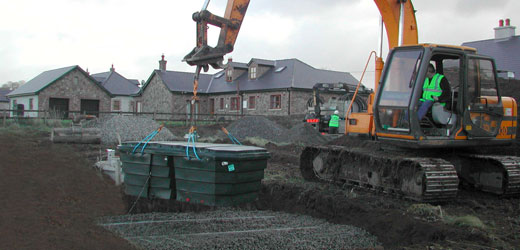Septic Tank Emptying
After emptying your septic tank our engineers will convert your existing septic tank or cesspit into a fully functional sewage treatment plant producing a high quality final effluent that can be discharged into a watercourse or soak away.
In Morecambe,Heysham and Lancaster, we also undertake gully cleaning, gutter clearance and blocked soak away. Our high tech fleet of vehicles also remove all liquid wastes including food waste and grease traps.

A brief explanation of septic tanks and maintenenance
When septic emptying it is necessary to ensure that health and safety laws are adhered to, that is where we come in; All Clear are fully licensed to empty and maintain septic tanks.
Basically a septic tank works in the same way that a sewage system does only on a smaller scale. Permanent tanks reduce waste in the anaerobic environment but portable tanks such as the ones used in self contained portable toilets need emptying as they are considerably smaller and are generally used by hundreds or thousands of people in a short space of time and therefore can overflow if not emptied.
The process of liquid separation is quite simple; the sewer pipe transports the raw sewerage to a primary settlement tank where the heavier solids settle at the bottom becoming sludge whilst the rest is on top, this is natural filtration. The sludge gets piped into an anaerobic digester where methane escapes but nothing comes in, once mineralised the waste is then used as land fill or sent to the incinerator. The settled sewage is pumped into an aeration tank where air is pumped through it to produce bacteria which eat up the waste and convert it to carbon dioxide, it is then passed into the secondary settlement tank and the sludge is taken out into the anaerobic digester whilst the remainder is passed into the final tank where nitrogen is removed through biological oxidation and the clean water is then put back into the river to start the process again.
We take care of everything from collection to the septic emptying, leaving you to get on with the running of your business.
What are septic tanks?
Essentially, you can think of a septic tank as a smaller sewage system. Placed underground, septic tanks are constructed from concrete, fibreglass or plastic to allow domestic wastewater to flow through the septic tanks for basic treatment. Septic tanks can act as a simple type of on-site sewage facility. Septic tanks are essential to help your household efficiently deal with wastewater in a costeffective and environmentally friendly manner.
Permanent septic tanks are highly effective, reducing waste in the anaerobic environment. In contrast, portable tanks such as those used in portable toilets require more attention and need to be emptied more often given that these septic tanks tend to be smaller and may be used by large crowds of hundreds or even thousands of people in a short window of time, with the possibility of these septic tanks overflowing if they are neglected and not emptied often enough. This means that they need regular cleaning and maintenance to avoid expensive problems occurring and escalating.
What services do we offer?
Following health and safety standards is of absolute importance when emptying septic tanks to ensure that there are no negative consequences. At All Clear, our team are fully licensed to empty and maintain septic tanks with safety as their top priority so that you don’t have to worry about anything when we empty your septic tank. From collection to emptying your septic tank, our highly trained team can look after everything so you can focus on running your business with confidence.
How do septic tanks work?
Whilst it can seem complex, liquid separation is quite straightforward. It involves the following:
1. First, natural filtration is undertaken by transporting the raw sewage from the sewage pipe to a primary settlement tank where the heavier solid material settles at the bottom in the form of sludge, whilst the rest of the material rests on top.
2. Next, the sludge gets piped into an anaerobic digester, which allows methane to escape.
3. Once mineralised, the waste material can be sent to the incinerator or used as land fill.
4. Afterwards, the settled sewage can be pumped into an aeration tank to produce bacteria that can convert the waste to carbon dioxide.
5. The waste is pumped into the secondary settlement tank and the sludge is taken out into the anaerobic digester. The remaining material is then taken out into the final tank, removing the nitrogen using biological oxidation.
6. The clean water can be put back into the river, allowing the process to start again.
What happens after we’ve emptied your septic tank? Once your septic tank has been emptied, our engineers can easily convert your current septic tank into a fully functional sewage treatment plant, which aims to produce a final high-quality effluent that can soak away or be discharged into a watercourse. We also undertake gully cleaning, gutter clearance and blocked soak away. Then, our fleet of high-tech vehicles can remove all liquid wastes such as food waste and grease traps, so that you don’t have to worry about a thing.
For more information about our septic tanks services or to get a free, no obligation quote, please feel free to contact our friendly team of expert professionals who are on hand to help you with query today!


